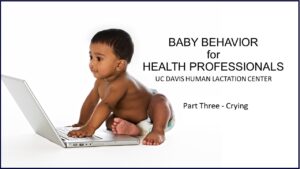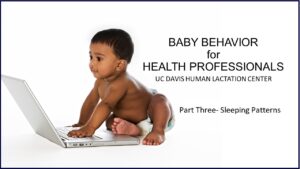This module is divided into two parts. In the first part of the module, you will learn about infant crying, caregivers perceptions of crying, inconsolable crying, and how to support caregivers to calm their infants effectively. In the second part of the module, you will learn about infant sleep patterns and how to improve caregivers expectations for infant sleep based on the infants’ age.
By the end of this module, you will be able to:
Part 1
- Describe the connection between caregiver response to cues and infant crying
- Describe specific actions that caregivers can take to soothe crying infants
- List common triggers for infant crying
- Differentiate between typical infant crying and inconsolable or excessive crying
- List risk factors for inconsolable or excessive crying in infants
- Describe resources for caregivers coping with inconsolable crying
Part 2
- Differentiate between two simplified concepts of infant sleep states
- List physiological benefits of changing sleep cycles during infancy
- Describe expected sleep patterns based on the age of infants up to 6-months of age
- Describe specific actions that caregivers of infants can take to get a little more sleep
Instructions:
- Click on each of the 3 links in order to complete the steps below.
- Be sure to complete each step before moving on to the next link.
Step 1. Click on the image or link below (Module 3: Part 1 – Infant Crying) to view the video:
Step 2. Click on the image or link below (Module 3: Part 2 – Infant Sleep) to view the video.
Step 3. Click on the link below for a self-assessment to test your ability to apply the knowledge and skills learned in this module.
Relevant Resources
Hiscock H. The crying baby. Aust Fam Physician. 2006;35(9):680.
Nugent J. Understanding Newborn Behavior & Early Relationships: The Newborn Behavioral Observations (NBO) System Handbook. Baltimore, MD: Brookes Pub; 2007.
Howard C, Lanphear N, Lanphear B, Eberly S, Lawrence R. Parental responses to infant crying and colic: the effect on breastfeeding duration. Breastfeeding Med. 2006;1(3):146-155.
Peirano P, Algarín C, Uauy R. Sleep-wake states and their regulatory mechanisms throughout early human development. J Pediatr. 2003;143(suppl 4):S70-S79.
Barnard K. Keys to developing early parent–child relationships. In: Lester B, Sparrow J, ed. Nurturing Children and Families. Malden, MA: Blackwell Publishing; 2010:53-63.
Kurth E, Spichiger E, Cignacco E, et al. Predictors of crying problems in the early postpartum period. J Obstet Gynecol Neonatal Nurs. 2010;39(3):250-262.
Halpern R, Coelho R. Excessive crying in infants. Jornal De Pediatria. 2016;92(3 suppl 1):S40-S45.
Barr R, Rajabali F, Aragon M, Colbourne M, Brant R. Education about crying in normal infants is associated with a reduction in pediatric emergency room visits for crying complaints. J Dev Behav Pediatr: JDBP. 2015;36(4):252-257.
Leavitt A. Infant crying: expectations and parental response. In: Barr R, St. James-Roberts I, eds. New Evidence on Unexplained Early Infant Crying: Its Origins, Nature, and Management. Langhorne, PA: Johnson and Johnson Pediatric Institute; 2001:43-50.
Douglas P, Hiscock H. The unsettled baby: crying out for an integrated, multidisciplinary primary care approach. Med J Aust. 2010;193(9):533-536.
Keefe M, Kajrlsen K, Lobo M, Kotzer A, Dudley W. Reducing parenting stress in families with irritable infants. Nurs Res. 2006;55(3): 198-205.
Kurth E, Kennedy H, Spichiger E, Hösli I, Stutz E. Crying babies, tired mothers: what do we know? A systematic review. Midwifery. 2011;27(2):187-194.
Chua C, Setlik J, Niklas V. Emergency department triage of the “incessantly crying” baby. Pediatr Ann. 2016;45(11):e394-e398.
Heraghty J, Hilliard T, Henderson A, Fleming P. The physiology of sleep in infants. Arch Dis Child. 2008;93(11):982-985.
Graven S, Browne J. Sleep and brain development: the critical role of sleep in fetal and early neonatal brain development. Newborn Infant Nurs Rev. 2008;8(4):173-179.
Galland B, Taylor B, Elder D, Herbison P. Normal sleep patterns in infants and children: a systematic review of observational studies. Sleep Med Rev. 2012;16(3):213-222.
Coons S, Guilleminault C. Development of consolidated sleep and wakeful periods in relation to the day/night cycle in infancy. Dev Med Child Neurol. 1984;26(2):169-176.
Whittingham K, Douglas P. Optimizing parent-infant sleep from birth to 6 months: a new paradigm. Infant Ment Health J. 2014;35(6):614-623.
Henderson J, France K, Owens J, Blampied N. Sleeping through the night: the consolidation of self-regulated sleep across the first year of life. Pediatrics. 2010;126(5):e1081-e1087.
Figueiredo B, Dias C, Pinto T, Field T. Infant sleep-wake behaviors at two weeks, three and six months. Infant Behav Dev. 2016;44:169-178.
Macknin M, Medendorp S, Maier M. Infant sleep and bedtime cereal. Am J Dis Children. 1989;143(9):1066-1068.
Public Health Programs and Resources
CDC Preventing Abusive Head Trauma
Period of Purple Crying Information
Crying in the First 3 Months – Seattle Children’s Hospital
_______________________________________________________________________________________________________________________________________________________



